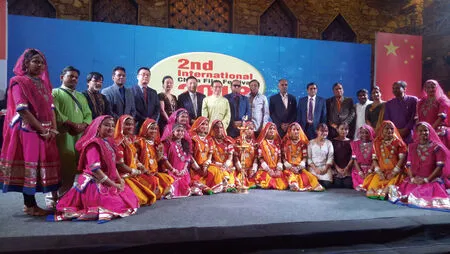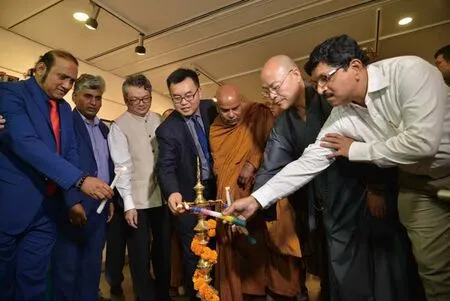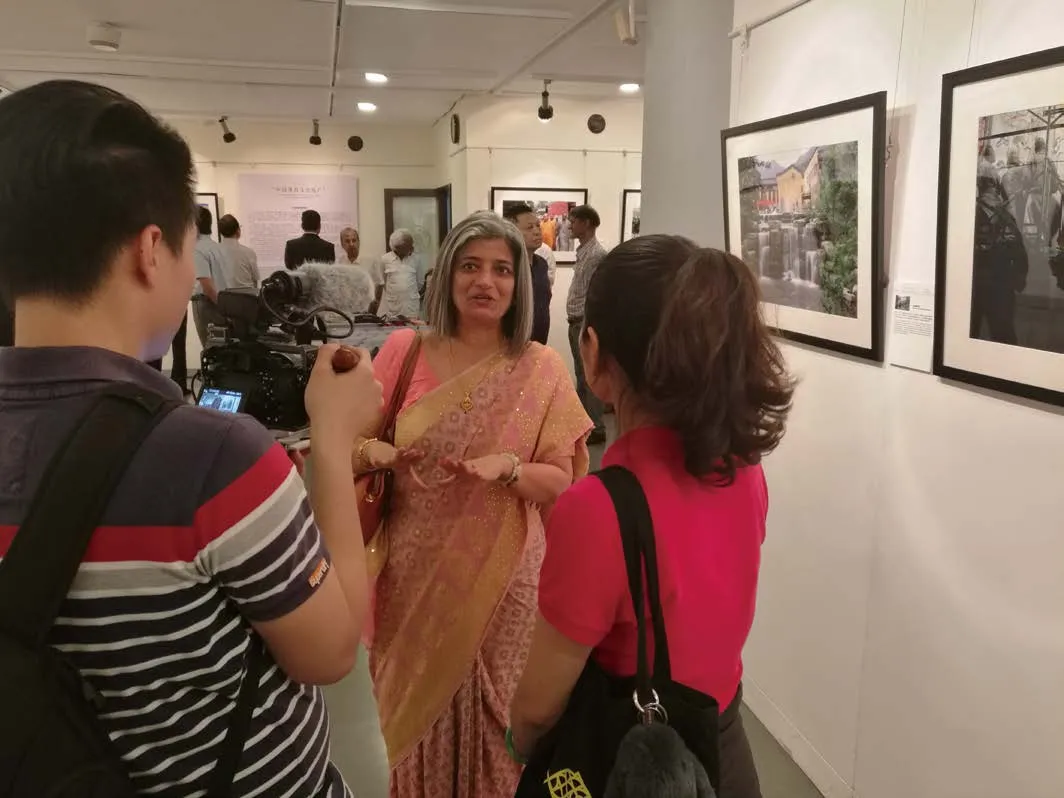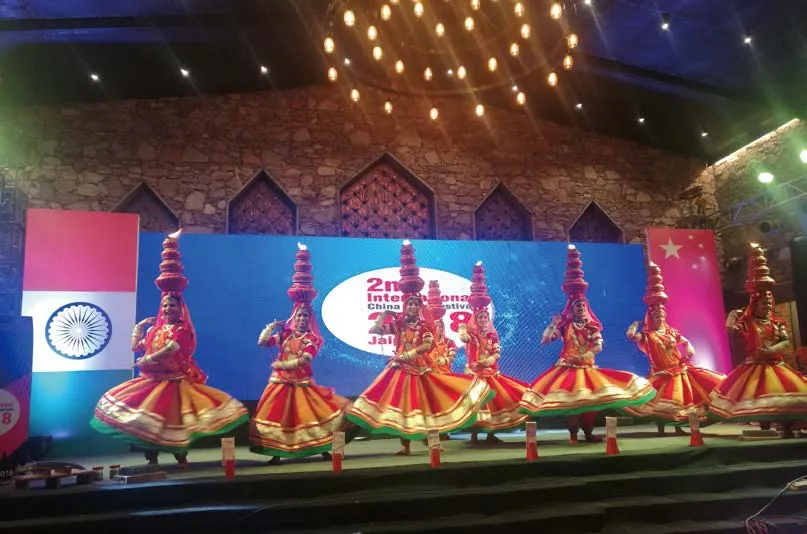艺术点亮心声文化传递友情
——“中国佛教文化遗产图片展”及“中国电影展映”活动走进印度侧记
2018-09-20MIAOHong
文苗 鸿 MIAO Hong

中国文联代表团一行与印度电影界知名人士合影CFLAC delegation takes group photo with celebrities from India's movie industry
如果你到印度随便询问一位当地居民,请他们谈谈对佛教和电影的感受,他们会很自然地“摇头”表示肯定,甚至会自豪且饶有兴致地侃侃而谈很长时间。印度是一个充满宗教色彩的神秘国度,印度民众对宗教的膜拜和对电影的喜爱似乎与生俱来。
为促进中印两国文化艺术交流与合作,增进两国人民之间的相互了解,在中国文联、印度文化关系委员会共同签署《合作备忘录》的基础上,3月16日至20日,由中国文联、中国佛教协会和印度孟买国家表演艺术中心联手主办,中国摄协、中国影协与印度音乐家联合会、马哈拉斯特拉邦艺术学院和印度中国电影学会共同承办的“今日中国”艺术周——“中国佛教文化遗产图片展”和“中国电影展映”活动分别在印度孟买、斋浦尔举办。
佛心相通,互信友爱,文明因交流而多彩
三月的佛国圣地印度,烈日高照,气温高达38度,坐落在孟买市的国家表演艺术中心是印度当地一处国家级文化艺术展示场所,能够在这里举办佛教文化遗产图片展览,可见规格不一般。
3月16日,在艺术中心美术馆展厅,中国摄协工作人员早已将装饰一新的图片布置陈列好,每件作品都配有中英文说明。作为人口大国的印度的确不缺观众——仪式尚未开始,当地政要官员、佛教界人士及各界观众已纷至沓来,展览现场人头攒动、摩肩接踵。中国佛教协会工作人员李海星介绍说:“我们将中国灵隐寺、大昭寺、睡佛雕像、山西大同云冈石窟、峨眉山普贤菩萨、宁玛派壁画等各地别具特色的佛教文化遗产风貌和佛教事业成就呈现给印度观众,让中印两国人文交流的潜力能够拓展和增强,助力两个文明古国的友好互鉴。”从印度观众仔细观赏一张张图片的神情看,仿佛观者在与作品进行着心灵的沟通,已领略到了图片所表达的意境,在展览中你言我语畅谈也好像没有多少障碍。中国佛教协会副秘书长、杭州灵隐寺方丈释光泉在仪式现场说:“在中印两千余年的友好交往中,佛教起到了重要纽带作用。这次展览从造像、建筑、圣物、庆典、教育、典籍等10余个方面展示的80幅图片是从近20000幅佛教文化遗产图片作品中遴选出来的,观众可以直观感受佛教文化在中国的历史发展和变迁,全方位展示中国佛教的历史文化瑰宝与当代发展风貌。”
“为增进中印两国文化彼此了解,促进两国人文交流与合作,两年来,中国文联与印度文化艺术界各方,积极组织开展在音乐、舞蹈、电影、摄影等领域的交流互访活动,双方密切合作,结伴同行,用艺术表达两国悠久的历史文化,传递两国人民源远流长的深厚友谊。”中国文联代表团团长苗宏说。共同分享人类文明成果,展示中国文化魅力成为此次活动亮点。中国驻孟买总领事郑曦原表示:“佛教给中国人的宗教信仰、哲学观念、文学艺术、礼仪习俗等产生了深刻影响,中国人根据中华文化发展了佛教思想,形成了独特的佛教理论,灿烂辉煌的佛教传统文化可以说是中印关系中的最大公约数。”
孟买佛教界对此次活动表现出极大热情和关注,积极评价两国对进一步推动佛教文化交流所作出的努力。近一周的展览吸引观众千余人次,应印方邀请还将到印度有关邦、市举办巡回展览。展览结束后,所有图片将由印度巴利佛学院珍藏。中印两国佛教界人士共襄盛举,体现了两国人民在慈悲仁爱精神传承上一种认同相连的亲密感情,此活动必将为巩固和发展中印传统友谊作出积极贡献。
艺术交流,传递互补,文明因借鉴而丰富
要说电影在印度更是不缺观众,印度电影票房收益可观。近几年,中印电影交流展映活动日益增多,其中印度电影《摔跤吧!爸爸》《神秘巨星》《小萝莉的猴神叔叔》等励志奋斗、彰显人性的电影作品令人耳目一新,给中国观众留下深刻印象。中印两国在电影交流合作方面有可借鉴的经验,作为“今日中国”艺术周的重要板块,中国电影展映活动中,中国影协带来了《捉妖记》《狼图腾》《一代宗师》《滚蛋吧!肿瘤君》《大唐玄奘》五部国产影片,在印度拉贾斯坦邦斋浦尔市电影院举办一周的展映活动。印度民众中喜欢电影的大有人在,看电影已经成为印度人生活的重要组成部分,一般情况下印度人在电影院里“泡”几个小时不成问题,每每看到精彩处还会随着电影音乐节奏舞动起来。这次展映活动得到了拉贾斯
坦邦政府支持和印度中国电影学会的高度重视,把电影展映活动放在印度古老的旅游城市拉邦首府斋浦尔举行。
在开幕式现场,笔者看到印方印制的精美的活动宣传广告,并以拉贾斯坦风格迎接远道而来的中国代表团一行,活动前还举行了“点灯”这一印度传统礼节不可少的祈福仪式。中国驻新德里大使馆得知活动消息后,专程派人驱车4个小时赶赴斋浦尔现场。驻印大使馆文化参赞张建新感慨地说:“在印度工作生活多年,很少看到印方为中国组织这样有规模、上档次的电影活动,说明选择电影艺术作为中印两国民间交往的纽带具有积极意义。”出席活动的印度知名导演、制片人、宝莱坞歌星等,在演出互动交流中增进友情,分享中印电影发展成果,感受中国电影魅力。国际电影负责人尼廷·莎玛说:“中国电影发展很快,中印观众都有共同电影喜好,中国功夫、喜剧片很受印度观众欢迎。”拉贾斯坦邦旅游局长普拉迪普·宝若拉在仪式上说:“中国电影市场潜力巨大,中国观众喜欢印度电影,同样,中国电影来到印度交流放映也有市场,希望两国多多加强电影交流合作。”中国影协副秘书长孙崇磊表示:“近年来,中印电影文化交流取得积极进展,中印两国在繁荣发展电影产业、促进世界电影多样化方面形成广泛共识,两国电影界积极为加强合作、相互借鉴、扩大交流创作了良好条件,印度电影走进中国,同时也期待越来越多的中国电影与印度观众见面。”
和睦认同,理解包容,文明因融合而持久

中印嘉宾共同为展览点灯 李晓元摄China and India guests jointly conduct lighting for the ceremony LI Xiaoyuan/Photo
季羡林先生曾说:“在全世界历史上要举一个文化交流使双方获利的例子,非中印文化交流莫属。”而印度诗人泰戈尔更是把中国和印度称作是“极老而又极亲爱的兄弟”。中印同为世界发展中的人口大国,两个比邻而居的伟大民族,文化历史悠久,交流源远流长,中印文化有着相似性的东方多元文化,在深化人文交流上有着相互借鉴和互补性,双方都始终保持“互信、和平、友爱”精神。这次系列活动正契合了友好发展的理念,在图片展览活动间隙,印方特意安排了中国佛教人士参观了印度宪法之父、新佛教运动领袖安倍德卡故居,并与印度法师一起在柴蒂亚布米佛寺举行了座谈会,还专程访问了索迈亚大学和佛教研究中心,印度青少年学生见到中国高僧的热情不亚于“追星族”,文化认同也是发自内心的。新华社和印度当地多家媒体这样评价:“佛教是展现和描绘辉煌人类文明多样性的世界级宗教,中印两国致力于通过音乐、茶道、武术、书画等方式来提高文化交流水平,通过展览看东方,这次佛教艺术展览提供了新的视角,让观众完成了一次视觉上的朝圣之旅。”
“多角度展示中国佛教文明发展,实在是让我们意想不到,更多了一份对中国的向往。”一位印度观众这样说。印方电影首席执行官基肖尔·贾瓦德说:“这次中国带来的影片题材丰富、风格多样,有助于加深印度观众对中国历史文化的了解和认识,中印电影可以相互借鉴,讲好故事,共同进步,寻求发展与共赢。”
If you go to India and ask a local resident casually if they could talk about the feelings of Buddhism and movies, they will naturally "shaking head" to affirm, even talk for a long time with pride and interests.India is a mysterious country full of religious colors. The Indian people's worship of religion and their passion for movies seem to be born with lives.
In order to promote exchanges and cooperation between China and India in cultural and artistic exchanges and enhance mutual understanding between the two peoples, "China Today" Art Week-"Photo Exhibition of Chinese Buddhist Cultural Heritage" and "Chinese Film Exhibition" events have been held in Mumbai and Jaipur of India respectively from 16-20 March under joint organization of China Federation of Literary and Art Circles, the Buddhist Association of China and Mumbai National Performing Arts Center. The events were undertaken by China Photographers Association, China Film Association, Indian Musicians Federation, Maharashtra State Art Institute and India-China Film Society based upon the signing of the Memorandum of Cooperation between CFLAC and Indian Council of Cultural Relationship.
Connecting hearts of Buddha, mutual trust & love, more colorful civilization due to exchanges
The holy land of the Buddha, India, is extremely hot and the temperature is as high as 38 degrees in March. The National Performing Arts Center in Mumbai is a local state-level cultural and arts exhibition venue in India. It is indeed particularly unique as it can hold Buddhist cultural heritage photo exhibitions.
On March 16th, the staff of the China Photographers Association had already displayed a new decoration of the picture layout in the exhibition hall of the museum art center, with each piece of work set with instructions in both Chinese and English.As a populous country, India does not lack audience. Local politicians, Buddhists and people from all walks of life have come before the ceremony officially started as the scene was crowded with so many people.LI Haixing, a staff member of the Buddhist Association of China, said: "We will have unique Buddhist cultural heritage and achievements of the Buddhist cause in China presented to Indian audiences, including Lingyin Temple, Jokhang Temple, statue of Sleeping Buddha, Yungang Grottoes of Datong, Shanxi, Samantabhadra of Emei Mount,Ningma-school murals and others to expand and enhance the cultural exchanges between China and Indiaand boost the two ancient civilizations to learn from each other through friendship and mutual understanding."From the look of Indian audiences admiring the pictures, it looked as if the viewer was engaged in spiritual communication with the work and has appreciated the artistic conception expressed in the picture. It also seems that there was not much obstacle in conversations in the exhibition.SHI Guangquan, the deputy secretary-general of the Buddhist Association of China and the abbot of the Lingyin Temple in Hangzhou, said at the ceremony: "In the more than two thousand years of friendly exchanges between China and India, Buddhism has played an important role. The 80 pictures displayed in the exhibition concerning more than a dozen aspects, such as sculptures, architecture, relics, festivals,celebrations, education and classics were selected from nearly 20,000 pieces of Buddhist cultural heritage photographs. The audiencescould intuitively experience the historical development and changes of Buddhist culture in China, displaying the historical and cultural treasures and contemporary development of China’s Buddhism in all directions."

图片展览吸引中印两国佛教界高僧、尊者、当地人士前来参观 苗鸿摄The photo exhibition attracts high-level sorghum, samurai and local people from the Buddhist circles of China and India. MIAO Hong/Photo
"In order to promote mutual understanding between the two countries' cultures and advance thebilateral cultural exchange and cooperation, CFLAC and related parties from Indian culture and arts circle have proactively organized exchanges and visits in terms of music, dance, film, photography and others.The two sides have worked closely and partnered together to express the long history and culture of the two countries through arts, conveying the profound friendship between the two peoples."said MIAO Hong, head of the CFLAC delegation.Sharing the achievements of human civilization and showcasing the charm of Chinese culture have become the highlights of this event.The Chinese Consul General in Mumbai, ZHENG Xiyuan said: "Buddhism has had a profound impact on Chinese people’s religious beliefs, philosophy, literature and arts, etiquette and customs. And the Chinese have developed Buddhist ideas based on our culture and formed unique Buddhist theories. The magnificent Buddhist traditional culture can be said to be the largest common divisor in Chinese-Indian relations."
The Buddhist community in Mumbai has showed great enthusiasm and interest for this activity and proactively evaluated the endeavors made by the two countries to further promote Buddhist cultural exchanges.The nearly one-week long exhibition has attracted more than a thousand visitors. It will also visit India’s other relevant states and cities to organize roving exhibitions at the invitation from Indian side. And all the pictures will be collected by the Indian Institute of after the exhibition ends. The people in the Buddhist circles of China and India have won a great success together, showing that the peoples of the two countries share a close feeling in the inheritance of the spirit of charity and benevolence. This activity will surely make positive contributions to consolidate and develop the traditional friendship between China and India.
Art exchange conveying complements, civilization becomes richer via learning
Movies are said to be most popular in India, showing considerable box office revenue. The recent years have witnessed an increasing number of film and television exchanges between China and India, including theDangal,Secret Superstar,BajrangiBhaijaanand other inspirational and humanistic Indian films have been refreshing,leaving a deep impression on the Chinese audiences.China and India share experience in film exchanges and cooperation. As an important section of the China Today Art Week, the Chinese Film Association has brought five domestic movies, includingMonster Hunt, Wolf Totem, The Grandmaster, Go away Mr. tumourandXuan Zang, holding a week-long event at the cinemas of Jaipur of Rajasthan in India. The Indian people love movies, aswatching movies has become an important part of their life. Under normal circumstances, it is not a problem for Indians to spend a few hours in the cinema, and they will dance with the rhythm of the movie music every time they find the dynamics. The exhibition was highly supported by the government of Rajasthan and the Chinese Film Society of India, designating the film screening event held in Jaipur, the capital of India's ancient tourist city Rajasthan.
At the opening ceremony, the author saw the beautifully printed promotional advertisements made by the Indian side,who greeted the Chinese delegation in Rajasthani’s way. The Indian traditional etiquette called "Lighting", an indispensable blessing ceremony was held before the event. After hearing the news about the event, the Chinese Embassy in New Delhi has designated officials to take 4-hour drive to Jaipur in particular.
ZHANG Jianxin, Cultural Counselor of the Chinese Embassy in India, said emotionally: "For years of working and living in India,we seldom see Indian side organizing such large-scale and highquality film events for China, stating that the choice of film arts as the link between the people of China and India is of positive significance." The well-known Indian directors, producers and Bollywood singers who attended the event gathered here have enhanced friendship in the interactive exchange of performances,share the achievements of development of Chinese and Indian films and experience the charm of Chinese movies.Nitin Sharma,director of international film, said: "Chinese films are developing rapidly. Chinese and Indian audiences share common preferences about film, as the Chinese kung fu and comedy movies are most popular with Indian audiences." PradeepBorar, Tourism Director of Rajasthan said at the ceremony: "The Chinese movie market has great potential. Chinese audiences like Indian movies as well.Similarly, there are also markets as the Chinese films come to India for exhibitions. I hope that the two countries will step up cooperation in film exchanges."SUN Chonglei, deputy secretarygeneral of the China Film Association, stated: "In recent years,China-India movie culture exchanges have achieved positive progress. The two nations have formed extensive consensus on the prosperity of the film industry and the promotion of diversification of the world's movies. The two countries' film industry has activelycreated a good condition for strengthening cooperation, learning from each other and expanding exchanges.As Indian movies enter into China, it is also expected that more and more Chinese films will debut in front of Indian audiences."

印度歌舞为展映活动助演Indian song and dance for the screening event
Recognition of harmony, understanding &tolerance, civilization everlasting via integration
JI Xianlin once said: "In the history of the world, cultural exchange between China and India must be the one if we should give an example of cultural exchanges that make both sides profitable." The Indian poet Tagore even called China and India "old and dear brothers".China and India, both the world's most populous and neighboring countries of great significance, have a long history of culture and pertinent exchanges. The cultures of the two nations share a similar oriental multiculturalism,featuring mutual reference and complementarity in deepening cultural exchanges. And both sides always maintain the spirit of "mutual trust, peace, and friendship". This series of activities is in line with the concept of friendly development. During the interim of the photo exhibition activities,the Indian side especially arranged Chinese Buddhists to visit the father of the Indian constitution,the former residence of leader of the new Buddhist movement Ambedkar, hold a symposium with the Indian mastersat temple of Chaitya Bhoomi and pay a special visit to the University of Somaiya and the Buddhist Research Center. Indian youth students were as passionate as the "idolaters of superstars" in meeting the Chinese monks, and the cultural recognition stemmed from the heart.Xinhua News Agency and a number of local Indian media made the following comments: "Buddhism is a world-class religion that displays and describes the diversity of glorious human civilization. China and India are committed to improving cultural exchange through music, tea ceremony, martial arts,calligraphy and painting. Observing the east through the exhibition, this Buddhist art exhibition provides a new perspective for the audiences to complete a visual pilgrimage."
"The multi-angle display of the development of Chinese Buddhist civilization is really an unexpected surprise for us, which also generates more of a yearning for China." said an Indian audience. Kishore Jawade, chief executive of the Indian film, said: "The rich subjects and variety of styles concerning the filmsbrought by China help deepen the understanding and acknowledgement of Chinese history and culture of the Indian audiences. Chinese and Indian films could learn from each other,tell greatstories, make progress together and seek development and mutual benefit."
